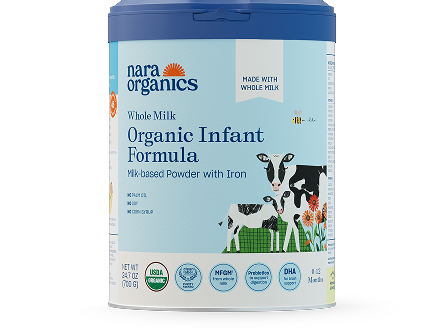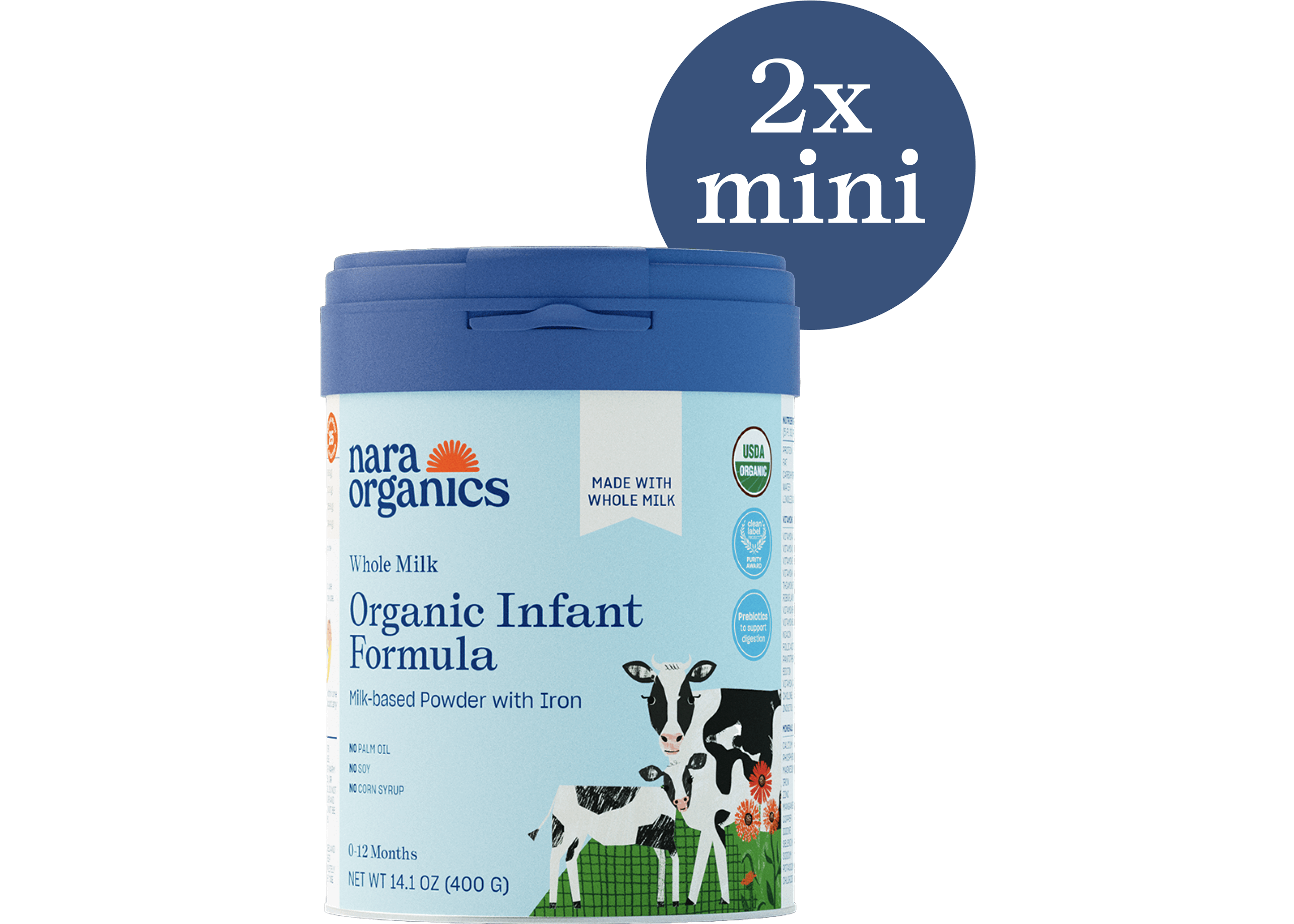There are endless reasons families choose to bottle feed both breastmilk and infant formula. Like everything with a new baby, there can be a bit of a learning curve. Below are a few things we wish we had known before giving our own babies a bottle for the first time.
The best age to introduce a bottle
If you’re breastfeeding and want to pump your breastmilk to bottle feed, or supplement breastfeeding with infant formula, the timing of when to offer the bottle is your choice. If you’re formula feeding from the start, then you’ll introduce a bottle right away.
Just ensure your baby has enough time to get used to the change before they really need to be bottle-fed. For instance, if you’re going back to work at 16 weeks, you should start bottle feeding at least two weeks (or more!) before your routine changes.
For the first few bottles, offer a small amount (½ ounce) an hour or two after a regular feed so your baby is hungry but not stressed. If you’ve been exclusively breastfeeding, it can be easier to have another adult offer the first few bottles, in a place where you don’t usually breastfeed.
The basic approach is slow and gentle. If your baby gets frustrated or is just not having it, take a break and then try a different bottle nipple flow or shape.
Choosing a bottle nipple flow
Before you offer that first bottle, select a bottle with a nipple suitable for your baby’s age. However, keep in mind while age may be a helpful starting point, it is not the only factor for determining which bottle nipple may work best for your little one.
Bottle nipples have different flow rates to match your baby’s feeding style. The size of the hole in the nipple determines how quickly or slowly the milk will flow. If the size is too big or too small, your baby may feed too quickly, too slowly, or swallow too much air. Generally, term infants will begin with a level 1, or a slow flow nipple, and progress to other levels as they develop their oral motor skills, allowing them to meet their need for increased volume as they mature.1
As a baby's feeding skills develop and they are taking a longer time feeding from their current nipple, it may be time for you to try the next nipple level up. Additionally, keep in mind that every baby feeds differently, so continue to be mindful and look for your baby’s cues that may indicate if they are hungry or are full.2
Babies who are both breastfed and bottle-fed often do better with a slower flow nipple as that matches the flow of feeding at the breast.
If you think your baby is getting frustrated during feeding, they’re taking a long time to finish the bottle, or if the nipple appears flat after feeding, it may be time to try a larger size nipple. However, if your baby is gulping, choking, or coughing during feedings, they may need a nipple with a slower flow.
It’s always best to talk with your baby’s pediatrician or healthcare provider about your baby's feeding habits or any concerns you have about their feeding and safety.
Bottle feeding positions
Bottle feeding is snuggly! It’s important to keep your baby upright and close to ensure safety when bottle feeding.3 It is not recommended to prop a baby up or put them to bed with a bottle, since this is unsafe, increasing their risk of choking, ear infections, and tooth decay).2
Whichever position you choose to feed your baby, make sure to keep the bottle at an angle rather than straight up and down. This lets your baby control the flow of milk by sucking, rather than gravity doing the work.

Cradle: the same popular position in breastfeeding can also be used for bottle feeding. Rest their head in the crook of your arm, and tilt them up with head and chest at a slight incline so they’re at a comfortable angle. This position keeps your baby close and you can even do skin-to-skin contact during the feed.3

Sitting upright: an ideal position for babies with reflux. Sit down and place your baby upright in your lap with their back against your stomach and chest.3
Storing formula & breastmilk bottles
Sometimes when you prepare infant formula or pump breastmilk, you don’t end up using it right away. Below is a chart that offers guidance on how long a prepared bottle of infant formula or expressed breast milk can be stored and used in different scenarios.2,4,5
This info is adapted from the CDC and the American Academy of Pediatrics.
Formula
- At room temp: 2 hours from mixing (Then use or discard)
-
In the fridge: 24 hours. Put it in the fridge right after mixing
(Never microwave to warm formula or breastmilk, since there could be hotspots in the liquid that can scald a baby if fed) - In the freezer: Not for freezing!
- Once feeding starts: 1 hour (Then discard leftovers)
Breast Milk
- At room temp: 4 hours (Then use or discard)
-
In the fridge: 4 days. Put it in the fridge right after mixing
(Never microwave to warm formula or breastmilk, since there could be hotspots in the liquid that can scald a baby if fed) - In the freezer: 6 - 12 months
- Once feeding starts: 2 hours (Then discard leftovers)
Washing & drying bottles and bottle parts
Keeping bottle parts clean is an important part of bottle feeding. Here are some great recommendations from the Mayo Clinic to follow before you begin using new bottles to help keep your little one safe.6
- It's important to sanitize them thoroughly to remove as many germs as possible.
- Clean the entire bottle, including the nipples, caps, and rings.
- Don’t forget to disinfect the tools you’ll use for cleaning, like bottle brushes.7
The CDC also recommends washing all bottle parts.
- They suggest washing them in a clean basin/bowl (which is only used to clean infant feeding items) with dishsoap and warm water.
- Washing directly in the sink isn’t recommended because germs in the sink could contaminate bottle parts.
- Rinse thoroughly under running water, then air dry items on a clean unused dishtowel or paper towel. Do not use a dish towel to rub or pat items dry because doing so may transfer germs to the items. There are also special drying racks just for pump and bottle parts, but clean towels do the trick.
Sanitize
In addition to washing, your baby’s bottles and bottle parts should also be frequently (depending on the age or advice of your baby’s doctor) sanitized. The CDC recommends sanitizing daily (or more often) if your baby is less than 2 months old, was born premature or has a weakened immune system.8
Methods to sanitize already cleaned bottles and bottle parts include the following.7,8
- Use a dishwasher. Run on a sanitizing heat drying cycle. Allow to cool.
- Boil. Place the disassembled feeding items into a pot and cover them completely with water. Heat the pot on the stovetop and wait until the water reaches a rolling boil, allowing the items to boil for five minutes. Lastly, use clean tongs, and carefully remove the items from the water and set them aside to dry on a clean paper towel.
- Steam. Place the disassembled bottles and feeding parts in the microwave or use a plug-in steam system. Follow the manufacturer’s instructions carefully for proper sanitizing, cooling, and drying.
We generally advise against using chemicals for sanitizing your baby’s bottles and bottles parts, or bottle brushes. Stick mainly to the cleaning methods listed above, as they are safer and effective options for sanitation.
Talk to your pediatrician
If you have questions about your infant’s feeding , your pediatrician is your best resource. They can help you understand the nutritional needs of your growing baby and guide you toward the best feeding choices for your family.





